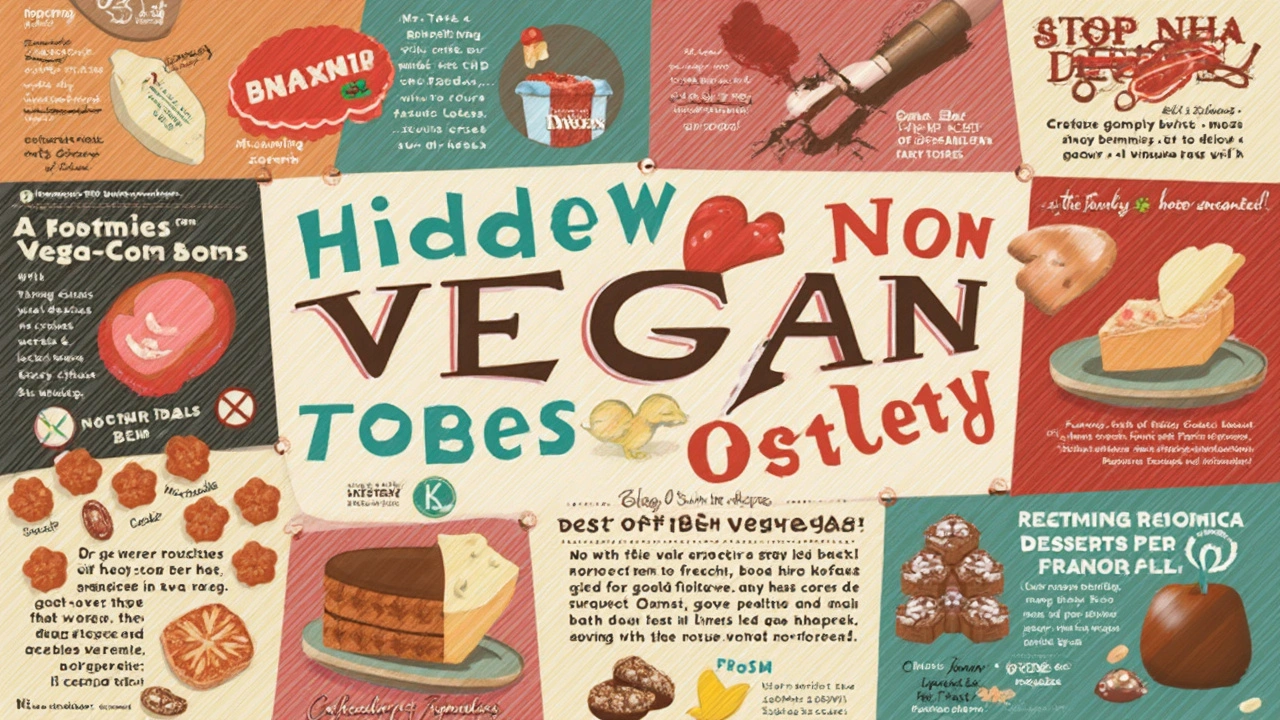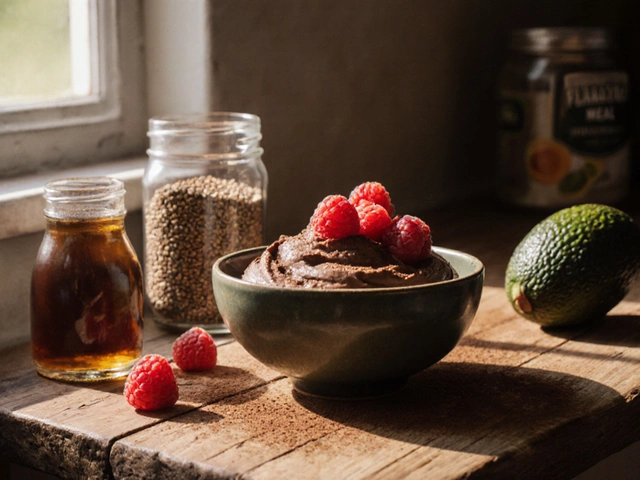Diving into the world of vegan desserts can feel like a maze filled with unexpected twists. One moment you're admiring a beautifully glazed donut, and the next you're realizing it wasn’t so vegan after all. It's like playing detective with your taste buds and ingredient lists. So, what's hiding in that scrumptious dessert trying to sneak past your vegan radar?
Gelatin is a big culprit here. You'd be surprised to find it not just in the obvious jello treats, but in foods like marshmallows and certain candies. Gelatin is derived from animal collagen, which means it’s a no-go for vegans. Fortunately, there are alternatives like agar-agar, which can rescue your recipes.
Ever wondered why some desserts have such vibrant colors? Some of those colors might come from carmine, a dye made from crushed cochineal insects. Yes, bugs! It’s often used for reds and pinks, so you might want to double-check labels when eyeing that raspberry sorbet.
- The Hidden Truth About Gelatin
- Animal-Derived Coloring Agents
- Surprising Non-Vegan Sugars
- Sneaky Shellac and Its Uses
- Whey and Casein in Sweet Treats
- Tips for Spotting Non-Vegan Ingredients
The Hidden Truth About Gelatin
When you're on the lookout for vegan desserts, gelatin is a common and sneaky ingredient that tends to pop up in unexpected places. This gummy delight is often misunderstood. Mostly, it serves as a thickening or stabilizing agent, making it a common addition in gummy candies, marshmallows, and many not-so-obvious treats like frostings and puddings.
Gelatin is derived from animal collagen, which is sourced from the by-products of the meat and leather industries. Not exactly what you’d want in a supposedly vegan dessert, right? A study from 2020 revealed that more than 80% of gelatin produced globally comes from pigs, while the rest comes mainly from cows. This means that many desserts, especially those with a chewy or wobbly texture, are off the vegan menu.
Alternatives You Can Use
Thankfully, all is not lost for vegan dessert lovers. There are plenty of alternatives that mimic gelatin's properties without compromising your vegan values. These plant-based alternatives can lead to equally delicious and satisfying desserts:
- Agar-Agar: Derived from seaweed, it works well in jellies and thickening desserts.
- Pectin: Often used in jams and jellies, extracted from fruits.
- Kudzu: This is quite effective for thickening and stabilizing as well.
"Understanding and substituting gelatin is vital for those committing to a vegan lifestyle. It's always best to scrutinize the ingredients list," says Dr. Jane Thompson, a nutrition expert and author of ‘Vegan in Today's World’.
Watch Out for Labels
At times, companies may not straightforwardly list 'gelatin' as an ingredient. Look for clues in labels — terms like 'stabilizers' or 'thickening agents' can sometimes be a giveaway. Being vigilant about checking labels is not just a practice but a habit for maintaining a true vegan diet.
Being aware of these gelatin traps ensures your dessert indulgence stays truly vegan. Remember, when in doubt, a quick bit of research can save you from unexpected surprises!
Animal-Derived Coloring Agents
Ever looked at a bright red candy and wondered about its origins? Here’s a spoiler: sometimes, those colors come from unexpected sources—like bugs! One of the most common animal-derived dyes is carmine, also known as cochineal extract. It's made by crushing cochineal insects, mainly for their vibrant red pigment.
Carmine isn't just a minor player; it shows up in a variety of foods. You can find it in items ranging from fruit-flavored yogurts to certain ice creams, and even fruit juices. The tricky part? It might not always be labeled as 'carmine'; sometimes it's listed as natural red 4 or E120. Sneaky, right?
Now, you might be wondering how to spot these coloring agents without becoming a full-time label reader. One tip is to look for products that are certified vegan or use plant-based dyes like beetroot or turmeric for coloring.
Alternatives and What to Watch For
If you’re fond of colorful desserts, don't worry—there are plenty of alternatives. Manufacturers are gradually switching to plant-based colorings like spirulina, used for blue tones, or beet juice for reds. These alternatives are a godsend for creating vibrant vegan desserts without relying on animal products.
A final heads-up: companies are getting better about listing ingredients clearly, so always have a quick glance over the label. Being informed helps you enjoy those tempting sweets without compromising your vegan values.
| Artificial Coloring | Plant-Based Alternative |
|---|---|
| Carmine | Beet Juice |
| Artificial Yellow | Turmeric |
| Blue No. 1 | Spirulina |
Surprising Non-Vegan Sugars
When it comes to vegan desserts, you'd think that sugar is a safe bet. After all, it's just sugar, right? But not all sugars are created equal in the vegan world. In the process of refining sugar, some manufacturers use bone char, which is made from the bones of cattle, to achieve that perfect white hue.
This bone char process is mostly used in the United States. In regions like Europe, it's less common, as they often use other methods for sugar refinement. To avoid this pitfall, look for sugars labeled as 'organic' or 'unrefined,' where bone char isn't used. Or, you can go with alternatives like coconut sugar, which also adds a lovely caramel flavor to your treats.
Industry Insight
According to Harold McGee, a renowned food science expert, "Most sugar in Europe doesn't use bone char, but in the U.S., it's something to be mindful of."
"Many vegans are surprised to learn about the bone char process, but it's important not to stress out over slip-ups. Opt for brands that clearly label their products as vegan to play it safe." — Vegan Society
Thankfully, several sugar brands are now catering to the vegan market. Companies like Florida Crystals and Sugar in the Raw are great options, offering vegan-friendly products that can sweeten up your favorite dishes without the animal-derived hang-ups.
If you're baking at home with non-vegan sugars, consider these tips:
- Check for labels that specifically say 'vegan' or 'bone char-free.'
- Try using raw cane sugar or other natural sweeteners like agave syrup or maple syrup.
- Use brown sugar, as it often doesn't undergo the same refining process.
Replacing non-vegan sugars in your sweet recipes is part of adapting to a mindful lifestyle. Once you're aware of the ingredients, it becomes easy to make informed choices.

Sneaky Shellac and Its Uses
When you think of a glossy candy coating, shellac isn't necessarily the first thing that comes to mind. But here's the scoop: that shiny finish on your favorite treats might actually be due to a substance derived from insects. Yep, shellac, also known as "confectioner's glaze," is created using secretions from the female lac bug. It's used to give items like jelly beans, chocolates, and some fruits that irresistible shine.
So, why should those on a vegan or plant-based diet be concerned? Well, even if it's just a shiny shell, any product using shellac doesn't align with vegan principles since it's a direct animal by-product.
Where You Might Encounter Shellac
- Confectionery: Look closely at those fruit-flavored candies and chocolate novelties. Many use shellac for that polished finish.
- Nuts: Some nuts, like almonds, get a glossy coating before hitting store shelves.
- Supplements: Oddly enough, shellac also finds its way into the pharmaceutical world, coating some vitamin tablets.
Spotting shellac in the ingredient list isn't always straightforward, as it's often listed under "confectioner's glaze" or simply "glaze." A good rule of thumb is to double-check with brands for clarification if you're aiming to keep your vegan desserts truly vegan.
Vegan-Friendly Alternatives
Worry not; there are vegan alternatives that create the same effect. Options like carnauba wax, derived from palm leaves, offer a plant-based shine. Areas of product labeling are constantly improving, which aids vegan consumers in making informed choices about the products they purchase.
Remaining vigilant by reading labels and asking questions is your best defense against these surprise ingredients. In essence, keeping your desserts vegan-friendly is a bit like a treasure hunt, uncovering unexpected traces and replacing them with friendly, plant-based counterparts.
Whey and Casein in Sweet Treats
Alright, let’s talk about whey and casein. These two are sneaky culprits that can ruin an otherwise promising vegan dessert. Both whey and casein are dairy proteins commonly found in a variety of sweet snacks. They might hide in the ingredient list of some candies, protein bars, and even baked goods without you even realizing it.
If you're a dessert lover trying to stay faithful to your vegan diet, these ingredients are like little traps waiting to snap. Whey is a byproduct of cheese production. Ever looked at a packaged brownie and wondered why it’s not vegan? Yep, it could be due to whey.
Where These Proteins Hide
It’s not just confections either. These proteins often lurk in processed pastry mixes or even in those deceptively healthy-looking energy bars. You might think you’re making a smart choice, but whey and casein have other plans. They add texture and protein, and manufacturers love them for it.
How to Avoid Them
Always check the packaging. If you see 'whey' or 'casein' on the list, put it back. Look for labels that explicitly state 'vegan' or 'dairy-free.' That sticker is often your best friend. Keep an eye out even in health food stores—just because it’s in that section doesn’t guarantee it's free from animal products.
If you love making your own desserts, there are tons of plant-based proteins out there that can work just as well in your recipes, like pea or soy protein. They’ll keep your desserts delicious and entirely plant-based.
Tips for Spotting Non-Vegan Ingredients
Navigating grocery aisles or restaurant menus is like embarking on a mini-adventure for those on a vegan journey. But don't worry, with the right knowledge, you can confidently steer clear of hidden non-vegan pitfalls. Let's take a closer look at some key pointers.
Check for Gelatin and Collagen
These are the obvious ones, derived from animal parts. When scanning through ingredient lists, pay close attention to words like gelatin or collagen, especially in sweets like gummies and marshmallows.
Watch Out for Animal-Based Colors
Those vibrant colors in candies might come from carmine (also known as cochineal or E120), which is made from insects. It's sneaky and often overlooked, so keep an eye out, especially on red-colored treats.
Sugar: Who Knew?
You might think sugar is a safe bet, but sometimes it's processed using bone char. While many brands now are aware of this and offer vegan certifications, it's worth verifying, particularly with white and brown sugars.
Understand Labels
Labels can be tricky. Words like casein, whey, or lactose indicate dairy derivatives. Even things labeled as 'natural flavors' could be animal-based; check for vegan certifications or contact manufacturers when in doubt.
Consider Allergens Section
Some products reveal their true nature in the allergen section, listing milk, honey, or eggs. They won't hide these ingredients, so scanning that part could save you a lot of guesswork.
Vegan tips: Familiarize yourself with common non-vegan ingredients and reach out for guidance from online vegan communities or apps dedicated to vegan eating. They can be great saviors when you feel lost!





